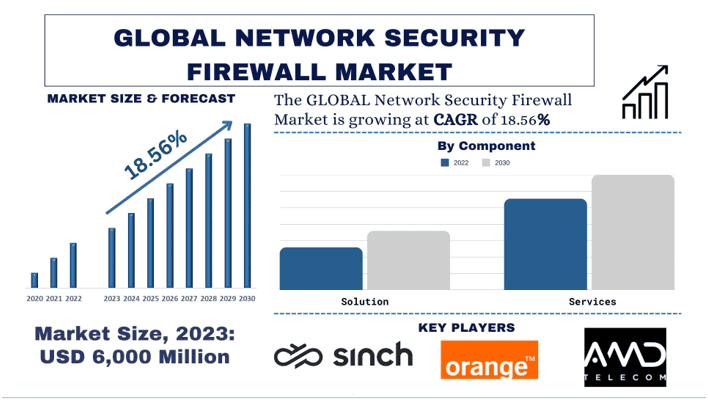
ネットワークセキュリティファイアウォール市場規模と予測
ネットワークセキュリティファイアウォール市場は60億米ドルと評価され、予測期間(2024~2032年)に約18.56%のCAGRで力強く成長すると予想されています。これは、サイバーセキュリティ脅威の増大によるものです。
ネットワークセキュリティファイアウォール市場分析
ネットワークセキュリティファイアウォールは、あらかじめ定められたセキュリティルールに基づいて、送受信されるネットワークトラフィックを監視および制御するように設計されたシステムです。ファイアウォールは、信頼できる内部ネットワーク(プライベートホームや企業ネットワークなど)と、信頼できない外部ネットワーク(インターネットなど)の間の障壁として機能します。その主な機能は、一連の設定可能なルールとポリシーに基づいて、特定のトラフィックを許可またはブロックすることです。このエントリポイントでトラフィックをフィルタリングすることにより、ファイアウォールは、外部ソースからの不正アクセス、マルウェア、およびその他の潜在的な脅威から内部ネットワークを保護するのに役立ちます。
今日のデジタル時代において、サイバーセキュリティはあらゆる業界の組織にとって最優先事項となっています。サイバー脅威が洗練さと頻度を増し続ける中、堅牢なセキュリティ対策、特にネットワークセキュリティファイアウォールの需要が急増しています。これらのファイアウォールは、悪意のあるトラフィック、不正アクセス、および潜在的なデータ侵害に対する最初の防衛線として機能し、あらゆる包括的なサイバーセキュリティ戦略に不可欠なコンポーネントとなっています。さらに、マルウェア、ランサムウェア、分散型サービス妨害(DDoS)攻撃、高度な持続的脅威(APT)などのサイバー脅威の蔓延により、より強力なセキュリティ対策の実装が必要となっています。たとえば、Ciscoによる2022年のサイバー脅威防御レポートによると、組織の86%が2021年に少なくとも1つのサイバー攻撃を経験しており、ネットワークとデータを保護するための堅牢なファイアウォールの緊急の必要性が浮き彫りになっていますさらに、クラウドコンピューティングの急速な普及と、COVID-19パンデミックによるリモートワークの増加により、組織の攻撃対象領域が拡大しました。従業員がさまざまな場所やデバイスから企業のリソースにアクセスするにつれて、ファイアウォールは、これらの分散ネットワークを保護し、不正アクセスを防ぐために不可欠になっています。さらに、デジタルトランスフォーメーションと進化するビジネスモデルに伴い、企業はクラウドコンピューティング、モバイルアプリケーション、eコマースプラットフォームなどの新しいテクノロジーを採用し、堅牢なネットワークセキュリティ対策の必要性が高まっています。ファイアウォールは、これらの新しいビジネスモデルを保護し、機密データとトランザクションを保護する上で重要な役割を果たし、あらゆる組織が安全に機能するための重要なコンポーネントとなっています。
ネットワークセキュリティファイアウォール市場の動向
このセクションでは、当社の調査専門家チームが特定した、ネットワークセキュリティファイアウォール市場のさまざまなセグメントに影響を与えている主要な市場動向について説明します。
銀行、金融、保険(BFSI)セクターは、世界中のネットワークセキュリティファイアウォール業界の主要なエンドユーザーセグメントとして際立っています。
BFSI業界は、機密性の高い金融データとトランザクションを保護するための厳格な規制とコンプライアンス要件の対象となります。ファイアウォールは、これらの規制基準を満たす上で重要な役割を果たします。さらに、金融機関は、膨大な量の機密データと金銭的取引を扱い、サイバー犯罪者にとって魅力的な標的となっています。ネットワークファイアウォールは、さまざまなサイバー脅威に対する最初の防衛線として機能します。さらに、BFSIセクターは重要なインフラストラクチャと見なされており、中断や侵害は経済と国民の信頼に深刻な影響を与える可能性があります。ネットワークファイアウォールは、ネットワークトラフィックを制御および監視することにより、この重要なインフラストラクチャを保護するのに役立ちます。さらに、BFSI業界は、オンラインバンキング、モバイルアプリケーション、クラウドベースのサービスの採用により、急速なデジタルトランスフォーメーションを経験しています。これらのデジタルチャネルが拡大するにつれて、攻撃対象領域も拡大し、堅牢なネットワークセキュリティが必要になります。このような要因により、BFSI業界はネットワークセキュリティファイアウォールの主要なエンドユーザーセグメントとなっています。
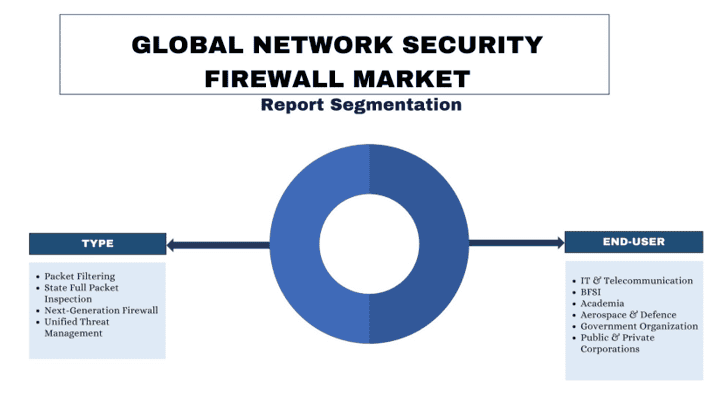
北米は、世界中のネットワークセキュリティファイアウォール市場で最大の市場として台頭しています。
北米内では、アメリカ合衆国が北米のネットワークセキュリティファイアウォール市場の大部分を占めています。市場の成長を後押しする主な要因は、世界的なテクノロジー業界におけるそのリーダーシップポジションです。さらに、アメリカ合衆国は、世界最大の銀行の一部の本拠地であり、堅牢なネットワークセキュリティファイアウォールインフラストラクチャの必要性を促進しています。
北米、特に米国は、技術革新と最先端のサイバーセキュリティソリューションのハブです。さらに、北米は、さまざまな業界にわたる多数の大企業と企業を擁する堅調な経済を誇っています。これらの組織は、リスクを効果的に軽減するためにネットワークセキュリティファイアウォールへの投資を含むサイバーセキュリティに多額のIT予算を割り当てています。さらに、世界最大のデジタル人口の1つである米国は、年間を通じてかなりの数のサイバー攻撃を目撃しています。2021年に実施された調査によると、米国のオンラインユーザーの約60%が何らかの形のサイバー攻撃に遭遇しており、サイバー犯罪の蔓延の点で3番目に高い国となっています。最新の報告年では、データの侵害のインシデントが米国で約2億9,400万人のインターネットユーザーに影響を与えました。さまざまな種類のサイバー攻撃の中で、ネットワーク侵入が国内で最も蔓延しており、政府がサイバーセキュリティ戦略への投資を増やすことを促し、ネットワークセキュリティファイアウォールに利益をもたらしています。たとえば、2024会計年度には、DHSがサイバーセキュリティに30億米ドル以上を割り当て、DoDを除くCFO法の政府機関の中で最高の資金提供機関となりました。米国の全体的なサイバーセキュリティ支出は2023年に増加し、総機関資金は104億6000万米ドルと推定されています。
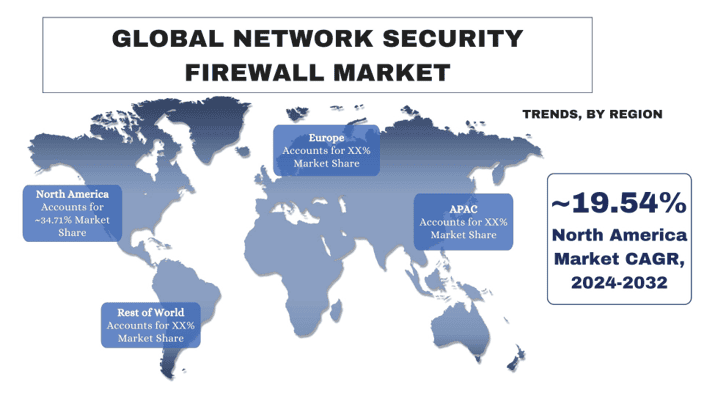
ネットワークセキュリティファイアウォール業界の概要
ネットワークセキュリティファイアウォール市場は競争が激しく細分化されており、いくつかのグローバルおよび国際的な市場プレーヤーが存在します。主要なプレーヤーは、パートナーシップ、合意、コラボレーション、新製品の発売、地理的拡大、合併、買収など、市場でのプレゼンスを強化するためのさまざまな成長戦略を採用しています。市場で活動している主要なプレーヤーには、Sinch、AMD Telecom、Orange、SAP、Sophos Ltd.、Tata Communications、Telecom Italia Sparkle S.p.A、Twilio Inc.、Route Mobile、Nokiaがあります。
ネットワークセキュリティファイアウォール市場ニュース
- 2024年1月 Zscaler Inc.は、完全なセキュアアクセスサービスエッジソリューションであるZscaler Zero Trust SASEと、Zero Trust SD-WANソリューションを発売しました。これらのソリューションは、組織の境界の内外を問わず、すべてを盲目的に信頼するのではなく、システムへのすべての接続を検証することを優先するゼロトラストアーキテクチャに基づいて構築されています。
- 2024年1月、世界経済フォーラム(WEF)が発表したレポートによると、組織の29%が、過去12か月間にサイバーインシデントによって重大な影響を受けたと報告し、過去12か月間に重大なインシデントに見舞われた組織の41%が、その原因が第三者によるものであると報告しました。
ネットワークセキュリティファイアウォール市場レポートの範囲
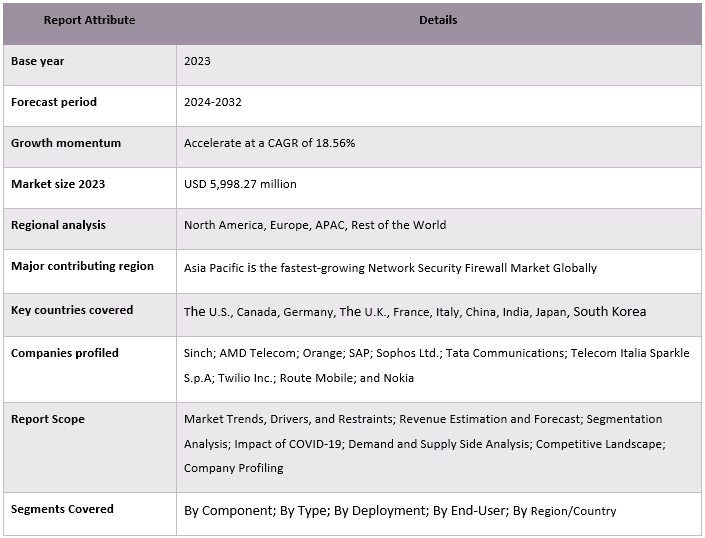
ネットワークセキュリティファイアウォール市場の範囲
このレポートを購入する理由:
- この調査には、認証された主要な業界専門家によって検証された市場規模と予測分析が含まれています。
- このレポートは、業界全体のパフォーマンスを1目で確認できる概要を提示します。
- このレポートは、主要なビジネス財務、製品ポートフォリオ、拡張戦略、および最近の動向に重点を置いて、著名な業界ピアの詳細な分析をカバーしています。
- 業界で蔓延しているドライバー、制約、主要なトレンド、および機会の詳細な調査。
- この調査は、さまざまなセグメントにわたる市場を包括的にカバーしています。
- 業界の詳細な地域レベル分析。
カスタマイズオプション:
グローバルネットワークセキュリティファイアウォール市場は、要件またはその他の市場セグメントごとにさらにカスタマイズできます。これとは別に、UMIは、お客様が独自のビジネスニーズを持っている可能性があることを理解しています。したがって、お客様の要件に完全に適合するレポートを入手するために、お気軽にお問い合わせください。
目次
ネットワークセキュリティファイアウォール市場分析(2024-2032年)の調査方法
過去の市場を分析し、現在の市場を推定し、グローバルネットワークセキュリティファイアウォール市場の将来を予測することは、主要地域におけるネットワークセキュリティファイアウォールの導入を作成および分析するために行われた3つの主要なステップでした。過去の市場数値を収集し、現在の市場規模を推定するために、徹底的な二次調査が実施されました。次に、これらの洞察を検証するために、数多くの調査結果と仮定が考慮されました。さらに、グローバルネットワークセキュリティファイアウォール市場のバリューチェーン全体にわたる業界専門家との徹底的な一次インタビューも実施されました。一次インタビューを通じて市場数値を仮定し、検証した後、トップダウン/ボトムアップアプローチを採用して、完全な市場規模を予測しました。その後、市場の細分化とデータの三角測量手法を採用して、業界のセグメントとサブセグメントの市場規模を推定および分析しました。詳細な方法は以下に説明します。
過去の市場規模の分析
ステップ1:二次情報源の詳細な調査:
ネットワークセキュリティファイアウォール市場の過去の市場規模を取得するために、詳細な二次調査が実施されました。これには、年次報告書および財務諸表、パフォーマンスプレゼンテーション、プレスリリースなど、および以下を含む外部ソースジャーナル、ニュース記事、政府刊行物、競合他社の出版物、セクターレポート、サードパーティデータベース、およびその他の信頼できる出版物。
ステップ2:市場セグメンテーション:
Network Security Firewall市場の過去の市場規模を取得した後、主要地域におけるさまざまなセグメントとサブセグメントの過去の市場洞察とシェアを収集するために、詳細な二次分析を実施しました。主要セグメントには、コンポーネント、タイプ、展開、エンドユーザーが含まれています。さらに、その地域におけるテストモデルの全体的な採用を評価するために、国レベルの分析が実施されました。
ステップ3:要因分析:
さまざまなセグメントとサブセグメントの過去の市場規模を取得した後、詳細な要因分析を実施し、Network Security Firewall市場の現在の市場規模を推定しました。さらに、Network Security Firewall市場のコンポーネント、タイプ、展開、エンドユーザーなどの従属変数と独立変数を使用して、要因分析を実施しました。世界中のNetwork Security Firewall市場セクターにおける主要なパートナーシップ、合併と買収、事業拡大、および製品発売を考慮して、需要と供給側のシナリオの徹底的な分析が実施されました。
現在の市場規模の推定と予測
現在の市場規模の算出:上記の3つのステップからの実用的な洞察に基づいて、現在の市場規模、世界のNetwork Security Firewall市場の主要プレーヤー、およびセグメントの市場シェアに到達しました。必要なすべてのパーセンテージシェアの分割と市場の内訳は、上記で言及した二次的なアプローチを使用して決定され、一次インタビューを通じて検証されました。
推定と予測:市場の推定と予測のために、推進要因と傾向、制約、および利害関係者が利用できる機会を含むさまざまな要因に重みが割り当てられました。これらの要因を分析した後、関連する予測手法、すなわちトップダウン/ボトムアップアプローチを適用して、世界中の主要市場におけるさまざまなセグメントとサブセグメントの2032年までの市場予測に到達しました。市場規模を推定するために採用された調査方法には以下が含まれます:
- 収益(USD)の観点からの業界の市場規模、および主要市場全体でのNetwork Security Firewall市場の採用率
- 市場セグメントとサブセグメントのすべてのパーセンテージシェア、分割、および内訳
- 提供される製品の観点からの世界のNetwork Security Firewall市場の主要プレーヤー。また、この急速に成長している市場で競争するために、これらのプレーヤーが採用している成長戦略。
市場規模とシェアの検証
一次調査:主要地域全体の主要オピニオンリーダー(KOL)と、最高経営責任者(CXO / VP、営業責任者、マーケティング責任者、運用責任者、地域責任者、カントリーヘッドなど)との間で詳細なインタビューが実施されました。一次調査の結果が要約され、表明された仮説を証明するために統計分析が実行されました。一次調査からのインプットは二次的な調査結果と統合され、それによって情報が実用的な洞察に変わりました。
さまざまな地域における一次参加者の内訳
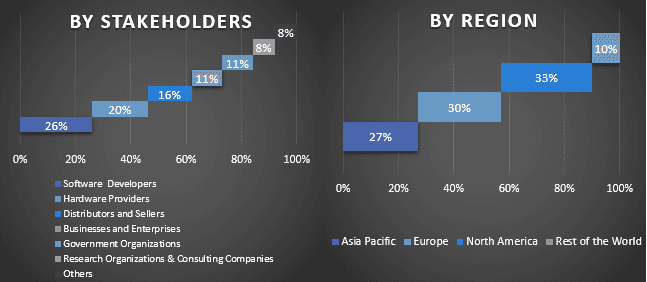
市場エンジニアリング
全体的な市場推定を完了し、世界のNetwork Security Firewall市場の各セグメントとサブセグメントの正確な統計数に到達するために、データの三角測量技術が採用されました。データは、世界のNetwork Security Firewall市場におけるコンポーネント、タイプ、展開、エンドユーザーの分野におけるさまざまなパラメータと傾向を調査した後、いくつかのセグメントとサブセグメントに分割されました。
グローバルNetwork Security Firewall市場調査の主な目的
グローバルNetwork Security Firewall市場の現在および将来の市場トレンドがこの調査で特定されました。投資家は、この調査で実行された定性的および定量的分析に基づいて、投資に関する独自の判断を決定するための戦略的洞察を得ることができます。現在および将来の市場トレンドは、地域レベルでの市場全体の魅力を決定し、産業参加者が未開拓の市場を利用して、ファーストムーバーの優位性から利益を得るためのプラットフォームを提供します。調査の他の定量的な目標には以下が含まれます:
- Network Security Firewall市場の現在の市場規模と予測市場規模を価値(USD)の観点から分析します。また、さまざまなセグメントとサブセグメントの現在の市場規模と予測市場規模を分析します。
- 調査のセグメントには、コンポーネント、タイプ、展開、エンドユーザーの分野が含まれます。
- Network Security Firewallの規制フレームワークを定義および分析する
- さまざまな仲介業者の存在に関連するバリューチェーンを分析し、業界の顧客と競合他社の行動を分析する
- 主要地域のNetwork Security Firewall市場の現在および予測市場規模を分析する
- レポートで調査された主要地域の国には、アジア太平洋、ヨーロッパ、北米、および世界のその他の地域が含まれます
- Network Security Firewall市場の企業プロファイルと、急速に成長している市場で持続するために市場プレーヤーが採用している成長戦略。
- 業界の詳細な地域レベルの分析
よくある質問 よくある質問
Q1: グローバルネットワークセキュリティファイアウォール市場の現在の市場規模と成長の可能性は?
Q2: グローバルネットワークセキュリティファイアウォール市場の成長を促進する要因は何ですか?
Q3: エンドユーザー別にグローバルネットワークセキュリティファイアウォール市場の主要部分を占めるセグメントは?
Q4: グローバルネットワークセキュリティファイアウォール市場における新興技術と動向は何ですか?
Q5: どの地域が最も急速に成長しているグローバルネットワークセキュリティファイアウォール市場になりますか?
Q6: グローバルネットワークセキュリティファイアウォール市場の主要プレーヤーは誰ですか?
関連 レポート
この商品を購入したお客様はこれも購入しました










